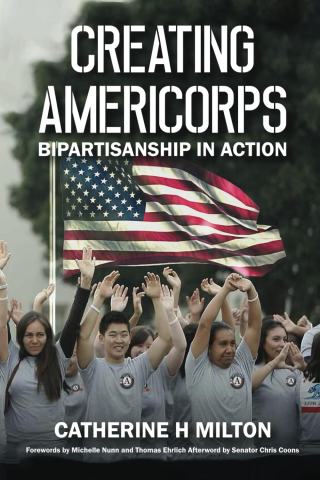Creating AmeriCorps: Bipartisanship in Action is my account of how a uniquely structured “presidential commission” became the engine that transformed national service from a general idea into a new federal program. The bipartisan Commission on National and Community Service laid the foundation for the AmeriCorps program that has survived the political ups and downs of the past 30 years and enabled over 1.2 million Americans to serve their country. As my account documents, using a presidential commission with the ability to fund and carefully evaluate a concept before its implementation is an excellent way to encourage innovation and can be a model for “reinventing” government.
In Creating AmeriCorps, I describe how national service went from an idea to an experiment, to a piece of legislation, to a full-fledged federal program in a few short years. For years, there had been calls to make domestic national service a reality: a domestic Peace Corps that would engage millions of people in community service. The book tells the story of how that idea became a reality, starting with a political compromise between Republican President George H. W. Bush and Democratic Senator Edward Kennedy. Bush wanted funding for his Points of Light program and Kennedy sought a domestic Peace Corps-like program. (The Points of Light Foundation helps celebrate volunteerism and to place volunteers in service opportunities. AmeriCorps sponsors and funds organizations that provide long-term paid service opportunities.) Their compromise created the bipartisan Commission on National and Community Service (CNCS) with the mandate and funding to make grants and test the best ideas for national and community service.
The fact that the presidential commission had the capacity to fund projects was significant—and unusual. Most presidential commissions only have the authority to advise and recommend, not fund new ideas. Putting together a request for proposals (RFP) forced the Commission to seek public input, through hearings around the country and written submissions. Through this wide public outreach consensus emerged on how to structure the grants in a way that enabled the evaluation of different approaches. The legislation setting up the commission only allowed ten staff members to be hired by the Commission and did not require civil service rules or political appointments. Congress had appropriated the grant funds for a maximum of two years. This limit on staff size and tight timetable meant that the bipartisan CNCS commission members, many with relevant expertise, needed to play an active role to get the work done. These conditions created a start-up atmosphere, encouraged teamwork, innovation, experiments, hard work, and the opportunity to learn from mistakes.
